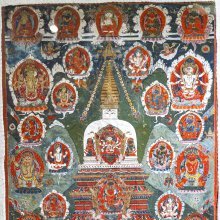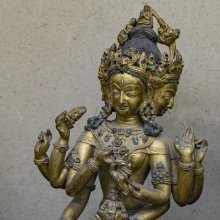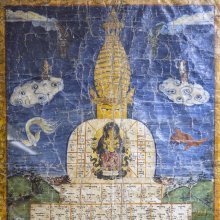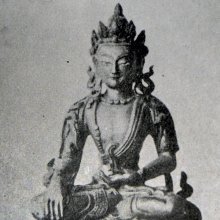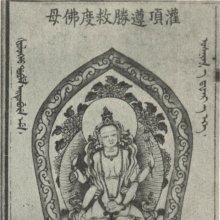Ushnisha, Uṣṇīṣā, Uṣṇīṣa: 26 definitions
Introduction:
Ushnisha means something in Buddhism, Pali, Hinduism, Sanskrit, the history of ancient India, Hindi. If you want to know the exact meaning, history, etymology or English translation of this term then check out the descriptions on this page. Add your comment or reference to a book if you want to contribute to this summary article.
The Sanskrit terms Uṣṇīṣā and Uṣṇīṣa can be transliterated into English as Usnisa or Ushnisha, using the IAST transliteration scheme (?).
Alternative spellings of this word include Ushnish.
Images (photo gallery)
(+14 more images available)
In Hinduism
Shilpashastra (iconography)
Source: Google Books: Elements of Hindu iconographyUṣṇīṣa (उष्णीष):—The Uttara-kāmikāgama gives the following rather long and somewhat unintelligible description of the uṣṇīṣa .
“The uṣṇīṣa-bhūśaṇa should be made so as to be of three aṅgulas in height. On its four sides there must be four pūris. In the middle of the uṣṇīṣa there must be a makarakūṭa with seven holes. On each side there has to be a patrakūṭa and on the back, a ratnakūṭa. The breadth of the uṣṇīṣa must be ten aṅgulas at the top, while at the base it has to be the same as that of the face of the wearer. A crescent of the moon has, in the case of the image of Śiva, to be attached to it either on the left or on the right side, and there is to be a cobra on the left side. Five jaṭās or braids of matted hair are taken and tied into a know three inches in height ny coiling them into one or three loops, the remaining braids being bound and taken through to be left hanging on both sides”
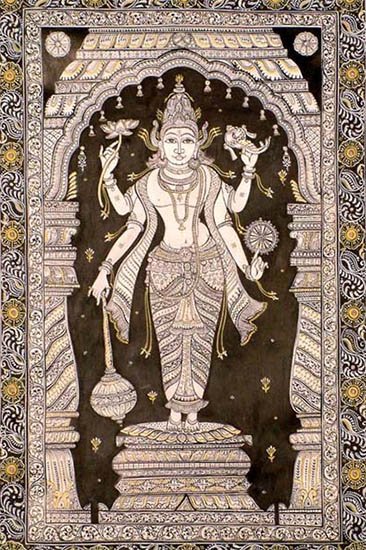
Shilpashastra (शिल्पशास्त्र, śilpaśāstra) represents the ancient Indian science (shastra) of creative arts (shilpa) such as sculpture, iconography and painting. Closely related to Vastushastra (architecture), they often share the same literature.
Vastushastra (architecture)
Source: Wisdom Library: Vāstu-śāstraUṣṇīṣa (उष्णीष) refers to a type of temple (prāsāda) classified under the group named Vairāja, according to Samarāṅgaṇasūtradhāra chapter 49. The Vairāja group contains twenty-four out of a sixty-four total prāsādas (temples) classified under five prime vimānas (aerial car/palace), which were created by Brahmā for as many gods (including himself). The group represents temples (e.g. Uṣṇīṣa) that are to be square shaped. The prāsādas, or ‘temples’, represent the dwelling place of God and are to be built in towns. The Samarāṅgaṇasūtradhāra is an 11th-century encyclopedia dealing with various topics from the Vāstuśāstra.
Uṣṇīṣa is also listed in the Agnipurāṇa which features a list of 45 temple types. It is listed under the group named Kailāśa, featuring circular-shaped temples. This list represents a classification of temples in Nort-India.
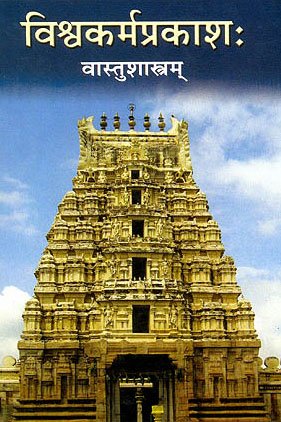
Vastushastra (वास्तुशास्त्र, vāstuśāstra) refers to the ancient Indian science (shastra) of architecture (vastu), dealing with topics such architecture, sculpture, town-building, fort building and various other constructions. Vastu also deals with the philosophy of the architectural relation with the cosmic universe.
Shaivism (Shaiva philosophy)
Source: Wisdom Library: ŚaivismUṣṇīṣa (उष्णीष, “turban”) refers to one of the five kinds of external marks of an ācārya (“Śaiva preceptor”), according to Nigamajñāna (Śaiva teacher of the 16th century) in his Śaivāgamaparibhāṣāmañjarī.
Source: Google Books: Manthanabhairavatantram (shaivism)Uṣṇīsa (उष्णीस) (Cf. Pīṭha) refers to a “turban”, according to the Niḥśvāsatattvasaṃhitā, one of the most ancient of extant Śaiva Tantras.—Accordingly, “Having offered a seat (pīṭha), umbrella, turban [i.e., uṣṇīsa] and knife, (one should say): ‘You are the teacher, Śiva's equal; exercise (your) grace in the world’.”.
Source: Brill: Śaivism and the Tantric TraditionsUṣṇīṣa (उष्णीष) refers to a “turban”, according to the 9th-century Sarvajñānottaratantra chapter 18.—Accordingly, “Next, I shall teach the best observance among observances, which is known as the Śiva-vrata and which is revered by Asuras and Gods alike. [...] He should be mantra-bodied; the appearance of excellent Sādhakas [who follow this observance] is to be the same as that of Śiva: the observance must be understood as consisting in this. Alternatively, he may wear [just] a white loin-cloth, [and bear] a turban (uṣṇīṣa), rosary and spouted water-pot. [...]”.
Source: SOAS University of London: Protective Rites in the Netra TantraUṣṇīṣa (उष्णीष) refers to a “crown” (for decoration), according to the Netratantra of Kṣemarāja: a Śaiva text from the 9th century in which Śiva (Bhairava) teaches Pārvatī topics such as metaphysics, cosmology, and soteriology.—Accordingly, [verse 2.17-19]—“The pure-souled Ācārya should draw an eight petaled lotus, in smooth, pure earth [that is] smeared with sandal and aloe wood [and] scented [with] fragrant camphor and strong saffron. After he has drawn [the lotus] with a great undertaking, [the Ācarya,] decorated and adorned with a crown (uṣṇīṣa), smeared with sandalwood, [writes] the mātṛkā. Having placed oṃ in the middle [on the pericarp of the lotus], he should draw [the phonemes of the mātṛkā on the petals] starting in the East”.

Shaiva (शैव, śaiva) or Shaivism (śaivism) represents a tradition of Hinduism worshiping Shiva as the supreme being. Closely related to Shaktism, Shaiva literature includes a range of scriptures, including Tantras, while the root of this tradition may be traced back to the ancient Vedas.
Purana and Itihasa (epic history)
Source: archive.org: Shiva Purana - English TranslationUṣṇīṣa (उष्णीष) refers to “one’s turban”, according to the Śivapurāṇa 2.4.14 (“The Gaṇas argue and wrangle”).—Accordingly, after Pārvatī’s friends spoke to Gaṇeśa: “On hearing the words of the friend and his mother Gaṇeśvara became highly delighted, strengthened and lifted up. Girting up his loins, tying his turban firmly (uṣṇīṣa) [tathoṣṇīṣaṃ baddhvā] and clapping his calves and thighs, he spoke fearlessly to all the Gaṇas”.

The Purana (पुराण, purāṇas) refers to Sanskrit literature preserving ancient India’s vast cultural history, including historical legends, religious ceremonies, various arts and sciences. The eighteen mahapuranas total over 400,000 shlokas (metrical couplets) and date to at least several centuries BCE.
General definition (in Hinduism)
Source: Wisdom Library: HinduismUṣṇīṣa (उष्णीष)—Sanskrit term corresponding to the english “turban”.
In Buddhism
Mahayana (major branch of Buddhism)
Source: Wisdom Library: Maha Prajnaparamita SastraUṣṇīṣa (उष्णीष, “crown”) refers to the “cranial protuberance”, from which the Buddha emitted numerous rays when he smiled with his whole body after contemplating the entire universe, according to the 2nd century Mahāprajñāpāramitāśāstra (chapter XIV).—Accordingly, having himself arranged the lion-seat, the Bhagavat sat down cross-legged; holding his body upright and fixing his attention, he entered into the samādhirājasamādhi. Then, having tranquilly come out of this samādhi and having contemplated the entire universe with his divine eye (divyacakṣus), the Bhagavat smiled with his whole body. Wheels with a thousand spokes imprinted on the soles of his feet (pādatala) shoot out six hundred prabhedakoṭi of rays. In the same way, beams of six hundred prabhedakoṭi of rays are emitted from his uṣṇīṣa.
After emission, the rays (raśmi) might return to the uṣṇīṣa (cranial protuberance), according to Mahāprajñāpāramitāśāstra (chapter XIV). According to the Avadānaśataka and Divyāvadāna, it is a custom that, at the moment when the Buddha Bhagavats show their smile, blue, yellow, red and white rays flash out of the Bhagavat’s mouth, some of which go up and some of which go down. Those that go down penetrate into the hells (naraka); those that go up penetrate to the gods from the Cāturmahārājikas up to the Akaniṣṭas. Having travelled through the trisāhasramahāsāhasralokadhātu, the rays return to the Bhagavat from behind. According as to whether the Buddha wishes to show such-and-such a thing, the rays return to him by a different part of the body.
The returning of the rays into the uṣṇīṣa of the Buddha predicts the anuttara-samyaksaṃbodhi of the Buddhas.
Source: De Gruyter: A Buddhist Ritual Manual on AgricultureUṣṇīṣa (उष्णीष) refers to the “topknot”, according to the Vajratuṇḍasamayakalparāja, an ancient Buddhist ritual manual on agriculture from the 5th-century (or earlier), containing various instructions for the Sangha to provide agriculture-related services to laypeople including rain-making, weather control and crop protection.—Accordingly, [after the Bhagavān witnessed the drought at the lotus-lake near Aḍakavatī], “Then the Bhagavān knew that this is experienced because of a cause of action. Still one should have mercy on them. The Bhagavān released rays from the treasure of hair. These rays illuminated all the Nāga residences. Having illuminated them, they turned back and disappeared up in the topknot (uṣṇīṣa)”.

Mahayana (महायान, mahāyāna) is a major branch of Buddhism focusing on the path of a Bodhisattva (spiritual aspirants/ enlightened beings). Extant literature is vast and primarely composed in the Sanskrit language. There are many sūtras of which some of the earliest are the various Prajñāpāramitā sūtras.
Tibetan Buddhism (Vajrayana or tantric Buddhism)
Source: Wisdom Library: Tibetan BuddhismUṣṇīṣa (उष्णीष) is the name of an Uṣṇīṣa king [i.e., Uṣṇīṣarāja] mentioned as attending the teachings in the 6th century Mañjuśrīmūlakalpa: one of the largest Kriyā Tantras devoted to Mañjuśrī (the Bodhisattva of wisdom) representing an encyclopedia of knowledge primarily concerned with ritualistic elements in Buddhism. The teachings in this text originate from Mañjuśrī and were taught to and by Buddha Śākyamuni in the presence of a large audience (including Uṣṇīṣa).
Source: archive.org: The Indian Buddhist Iconography1) Uṣṇīṣa (उष्णीष) refers to a class of gods in Vajrayāna.—The word uṣṇīṣa means “the crown” but the deities have nothing to do with the crown. They are usually placed like the gods of Direction, in the four principal directions and the four intermediate corners. These eight Uṣṇīṣa gods seem to be an extension of the four Dhyāni Buddhas, and they show their characteristic symbols and mudrās.
2) Uṣṇīṣa (उष्णीष) presides over the sky (above) and represents one of the ten deities of the quarters (Dikpāla) commonly depicted in Buddhist Iconography, and mentioned in the 11th-century Niṣpannayogāvalī of Mahāpaṇḍita Abhayākara.—His Colour is yellow; he has three faces and six arms.—The ninth deity in this series is Uṣṇīṣa who is also known as Uṣṇīṣacakravartī, and presides over the sky above.
Uṣṇīṣa is described in the Niṣpannayogāvalī (mañjuvajra-maṇḍala) as follows:—
Source: academia.edu: The Structure and Meanings of the Heruka Maṇḍala“In the upper region there is Uṣṇīṣa-Cakravartī of yellow colour. His three faces are yellow, blue and red. He holds the yellow discus, the sword, the jewel and the lotus”.
[His two principal hands hold the śakti as usual.]
Uṣṇīṣā (उष्णीषा) or Uṣṇīṣī is the name of a Ḍākinī who, together with the Vīra (hero) named Uṣṇīṣa forms one of the 36 pairs situated in the Hṛdayacakra, according to the 10th century Ḍākārṇava chapter 15. Accordingly, the hṛdayacakra refers to one of the four divisions of the sahaja-puṭa (‘innate layer’), situated within the padma (lotus) in the middle of the Herukamaṇḍala. The 36 pairs of Ḍākinīs [viz., Uṣṇīṣā] and Vīras are reddish yellow in color; they each have one face and four arms; they hold a skull bowl, a skull staff, a small drum, and a knife.

Tibetan Buddhism includes schools such as Nyingma, Kadampa, Kagyu and Gelug. Their primary canon of literature is divided in two broad categories: The Kangyur, which consists of Buddha’s words, and the Tengyur, which includes commentaries from various sources. Esotericism and tantra techniques (vajrayāna) are collected indepently.
India history and geography
Source: Cologne Digital Sanskrit Dictionaries: Indian Epigraphical GlossaryUṣṇiṣa.—cf. Prakrit uṃnisa (EI 20; LL), a coping stone. (EI 8), protuberance of the Buddha's skull. Note: uṣṇiṣa is defined in the “Indian epigraphical glossary” as it can be found on ancient inscriptions commonly written in Sanskrit, Prakrit or Dravidian languages.

The history of India traces the identification of countries, villages, towns and other regions of India, as well as mythology, zoology, royal dynasties, rulers, tribes, local festivities and traditions and regional languages. Ancient India enjoyed religious freedom and encourages the path of Dharma, a concept common to Buddhism, Hinduism, and Jainism.
Languages of India and abroad
Sanskrit dictionary
Source: DDSA: The practical Sanskrit-English dictionaryUṣṇīṣa (उष्णीष).—[uṣṇamīṣate hinasti īṣ ka Tv.]
1) Anything wound round the head. रक्तोष्णीषधराः स्त्रियः (raktoṣṇīṣadharāḥ striyaḥ) Rām. 6.8.6. उष्णीषबन्धस्थाने ललाटोपरि पट्टबन्धरेखा (uṣṇīṣabandhasthāne lalāṭopari paṭṭabandharekhā).
2) Hence, a turban, diadem, crownet; बलाकापाण्डुरोष्णीषम् (balākāpāṇḍuroṣṇīṣam) Mṛcchakaṭika 5.19. हेमासने कृतोष्णीषमभिषिच्य नृपं व्यधात् (hemāsane kṛtoṣṇīṣamabhiṣicya nṛpaṃ vyadhāt) Bm.1.678. उष्णीषेणैव शुचिना व्यभादुत्तंसधारिणा (uṣṇīṣeṇaiva śucinā vyabhāduttaṃsadhāriṇā) Śiva. B.21.29. and 22.8. °पट्ट (paṭṭa) K.16; Ratnāvalī 1.4.
3) A distinguishing mark.
4) A characteristic mark (of hair) on the head of a Buddha which indicates his future sanctity उष्णीषः स्फुट एष मूर्धनि विभात्यूर्णेयमन्तर्भुवोः (uṣṇīṣaḥ sphuṭa eṣa mūrdhani vibhātyūrṇeyamantarbhuvoḥ) Nāg.1.17.
5) The top of a building.
Derivable forms: uṣṇīṣaḥ (उष्णीषः), uṣṇīṣam (उष्णीषम्).
Source: Cologne Digital Sanskrit Dictionaries: Edgerton Buddhist Hybrid Sanskrit DictionaryUṣṇiṣa (उष्णिष).—(m.c. for uṣṇīṣa), excrescence on the head: °ṣodgato (= °ṣa udgataḥ) Rāṣṭrapālaparipṛcchā 6.18 (verse).
--- OR ---
Uṣṇīṣa (उष्णीष).—(1) nt. (in Sanskrit also m.; = Pali uṇhīsa), in Sanskrit only turban; in [compound] uṣṇīṣa-śīrṣa(n) or -śiras(ka), 32d of the 32 lakṣaṇa, q.v. (Pali uṇhīsa-sīsa), according to Pali Dīghanikāya (Pali) commentary ii.452.1 ff. having a head the size and shape of which makes it seem turbanned. But in [Buddhist Hybrid Sanskrit] (and Pali) interpreted as having a head surmounted by an excrescence, whether a top-knot of hair, or a growth in the skull. So Tibetan regularly (uṣṇīṣa = gtsug tor), e.g. on Mahāvyutpatti 236 uṣṇīṣa-śiraska-tā. Confirmed by Gaṇḍavyūha 401.26 ff. mūrdhni cāsyoṣṇīṣam abhinirvṛttam abhūt, sujātaṃ samanta- parimaṇḍalaṃ madhyābhinyastakeśālaṃkāraṃ koṭīśatasa- hasrapattraratnapadmasaṃdarśitaṃ samantāt samabhā- gapratiṣṭhitam aparimitamahārghyatāpradhānamadhyam. Cf. also uṣṇi, apparently = uṣṇīṣa in this sense, and uṣṇiṣa. In composition as one of the lakṣaṇa, Lalitavistara 105.11; 432.13; Dharmasaṃgraha 83; Mahāvastu i.227.3; ii.30.6; 307.4; Bodhisattvabhūmi 376.7; (2) m., one of ten Krodha: Dharmasaṃgraha 11; (3) in (Ārya-)Mañjuśrīmūlakalpa 41.7 aṣṭau uṣṇīṣarājānaḥ are mentioned as to be depicted in a rite; their names, given 41.10—11, are Cakra- vartin, Uṣṇīṣa, Abhyudgatoṣṇīṣa, Sitātapatra, Jayoṣṇīṣa, Kamaloṣṇīṣa, Tejorāśi, Unnatoṣṇīṣa. They seem not to be related to the Krodha of Dharmasaṃgraha 11, tho the first two names also occur in that list. Nothing significant is said of them.
Source: Cologne Digital Sanskrit Dictionaries: Shabda-Sagara Sanskrit-English DictionaryUṣṇīṣa (उष्णीष).—mn.
(-ṣaḥ-ṣaṃ) 1. A turban. 2. A diadem. 3. A distinguishing cognate mark. 4. The curly hair with which a Budd'ha is born, and which indicates his future sanctity. E. uṣṇa heat, īṣ to oppose or injure, ka aff.
Source: Cologne Digital Sanskrit Dictionaries: Benfey Sanskrit-English DictionaryUṣṇīṣa (उष्णीष).—m. and n. A diadem, a turban,
Uṣṇīṣa (उष्णीष).—[masculine] [neuter] turban, headband, diadem.
Source: Cologne Digital Sanskrit Dictionaries: Monier-Williams Sanskrit-English Dictionary1) Uṣṇīṣa (उष्णीष):—[from uṣ] mn. (uṣṇam īṣate hinasti, śakandhv-ādi [vArttika] on [Pāṇini 6-1, 94] para-rūpam, [Tārānātha tarkavācaspati’s Vācaspatyam, Sanskrit dictionary]) anything wound round the head, turban, fillet, [Atharva-veda xv, 2, 1-4; Śatapatha-brāhmaṇa; Āśvalāyana-śrauta-sūtra; Kātyāyana-śrauta-sūtra; Mahābhārata] etc.
2) [v.s. ...] a diadem, crown, [cf. Lexicographers, esp. such as amarasiṃha, halāyudha, hemacandra, etc.]
3) [v.s. ...] a kind of excrescence on the head of Buddha.
Source: Cologne Digital Sanskrit Dictionaries: Yates Sanskrit-English DictionaryUṣṇīṣa (उष्णीष):—[(ṣaḥ-ṣaṃ)] 1. m. n. A turban, a diadem; distinguishing mark.
Source: DDSA: Paia-sadda-mahannavo; a comprehensive Prakrit Hindi dictionary (S)Uṣṇīṣa (उष्णीष) in the Sanskrit language is related to the Prakrit word: Uṇhīsa.
[Sanskrit to German]
Sanskrit, also spelled संस्कृतम् (saṃskṛtam), is an ancient language of India commonly seen as the grandmother of the Indo-European language family (even English!). Closely allied with Prakrit and Pali, Sanskrit is more exhaustive in both grammar and terms and has the most extensive collection of literature in the world, greatly surpassing its sister-languages Greek and Latin.
Hindi dictionary
Source: DDSA: A practical Hindi-English dictionaryUṣṇīṣa (उष्णीष) [Also spelled ushnish]:—(nm) a turban; crown.
...
Kannada-English dictionary
Source: Alar: Kannada-English corpusUṣṇīṣa (ಉಷ್ಣೀಷ):—
1) [noun] anything wound round the head, as a covering; a head-gear.
2) [noun] an ornamental head-dress worn by a king as a symbol of sovereignty or the one the idols of gods are dressed with; a crown.
3) [noun] a protuberance on the top of the head of effigies of accomplished saints (corresponding to the ಸಹಸ್ರಪದ್ಮ [sahasrapadma] of mysticism).
Kannada is a Dravidian language (as opposed to the Indo-European language family) mainly spoken in the southwestern region of India.
See also (Relevant definitions)
Starts with: Ushnishabhajana, Ushnishacakravarti, Ushnishadharana, Ushnishadharin, Ushnishakoshasarvadharmaprabhamandalamegha, Ushnishapatta, Ushnisharpana, Ushnishashiraska, Ushnishashiraskata, Ushnishashobhana, Ushnishashri, Ushnishavijaya, Ushnishavijayatara.
Ends with: Abjoshnisha, Chatroshnisha, Dhvajoshnisha, Nirushnisha, Padmoshnisha, Ratnoshnisha, Tejoshnisha, Tikshnoshnisha, Tushnisha, Vajroshnisha, Vishvoshnisha.
Full-text (+59): Ushnishin, Ushnishadharin, Ushnisharpana, Ushnishavijaya, Jayoshnisha, Unhisa, Sitatapatra, Tejorashi, Ushnishashiraskata, Abhyudgatoshnisha, Kamaloshnisha, Ushnishapatta, Shilpatva, Ushnishabhajana, Ushnishadharana, Cakravartin, Tejaspada, Unnitam, Unnatoshnisha, Ushnish.
Relevant text
Search found 33 books and stories containing Ushnisha, Uṣṇīṣā, Uṣṇīṣa, Usnisa, Uṣṇiṣa; (plurals include: Ushnishas, Uṣṇīṣās, Uṣṇīṣas, Usnisas, Uṣṇiṣas). You can also click to the full overview containing English textual excerpts. Below are direct links for the most relevant articles:
The Indian Buddhist Iconography (by Benoytosh Bhattachacharyya)
Bhakti-rasamrta-sindhu (by Śrīla Rūpa Gosvāmī)
Verse 3.3.69 < [Part 3 - Fraternal Devotion (sakhya-rasa)]
Verse 2.1.351 < [Part 1 - Ecstatic Excitants (vibhāva)]
Amaravati Art in the Context of Andhra Archaeology (by Sreyashi Ray chowdhuri)
Resemblance to Mathurā art < [Chapter 5 - Impact of Amarāvatī Art]
Impact of Amarāvatī on early schools of art of South-East Asia < [Chapter 5 - Impact of Amarāvatī Art]
Anthropomorphic depiction of Buddha < [Chapter 3 - Amarāvatī and the Formative Stage of the Buddhist Art]
Jain Remains of Ancient Bengal (by Shubha Majumder)
Single depiction of Candraprabha sculptures < [Chapter 6 - Iconographic Study of Jaina Sculptural Remains]
Single depiction of Pārśvanātha sculptures < [Chapter 6 - Iconographic Study of Jaina Sculptural Remains]
Single depiction of Mahāvīra sculptures < [Chapter 6 - Iconographic Study of Jaina Sculptural Remains]
Manasara (English translation) (by Prasanna Kumar Acharya)
Chapter 57 - The images of the sages (muni-lakṣaṇa)
Chapter 56 - The Buddhist images (bauddha-lakṣaṇa)
Part 5 - General survey (summary of contents) < [Preface]
Cosmetics, Costumes and Ornaments in Ancient India (by Remadevi. O.)
2.1. Upper Garments (a): Head Dress: Uṣṇīṣa < [Chapter 2 - Costumes]
2.24. Sacrificial Dress < [Chapter 2 - Costumes]
2.1. Various other Head Ornaments < [Chapter 3 - Ornaments]
Related products
